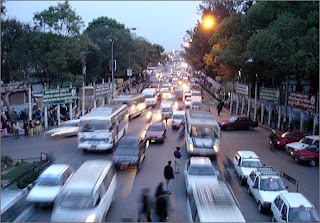The roads to sustainability?

"Roughly one out of every six American workers commutes more than forty-five minutes, each way. People travel between counties the way they used to travel between neighborhoods. The number of commuters who travel ninety minutes or more each way—known to the Census Bureau as “extreme commuters”—has reached 3.5 million, almost double the number in 1990. They’re the fastest-growing category, the vanguard in a land of stagnant wages, low interest rates, and ever-radiating sprawl."So given the above, is it possible that: (1) Better roads lead to less emission from car traffic? and (2) Restraining the capacity in the road network is an environmentally unsound measure to promote lower emission from road traffic? Those are among the conclusions reported by researchers in a recently released study, "Environmental consequences of better roads" by the European Union Road Federation. (GW)
EurActiv
13 April 2007
Bigger and better roads contribute to cutting pollution by removing bottlenecks, states a report commissioned by the EU Road Federation. The study follows criticism from green groups that investing in roads is contrary to Europe's sustainable development goals.
“More investment in road infrastructure is needed to remove bottlenecks, avoid city centres and complete missing links which together cost billions every year in lost fuel and undoubtedly contribute to the transport sector’s environmental footprint,” said the European Union Road Federation (ERF), in a paper published on 10 April 2007.
Citing a study undertaken by an independent Norwegian research organisation, the SINTEF Group, the ERF claims that infrastructure capacity increases are directly linked to decreases in polluting emissions from motor vehicles.
Using a traffic micro-simulation, SINTEF researchers showed, for example, that upgrading narrow, winding roads with modern ones or adding a lane to a congested motorway can yield decreases of up to 38% in CO2 emissions, 67% in CO emissions and 75% in NOx emissions, without generating substantially more car trips.
“Cases where road authorities and municipalities have deliberately restrained capacity to jugulate demand have been found to be environmentally counterproductive,” said the ERF.
The study follows calls by green NGOs to curb the growth in road transport in favour of more sustainable transport systems, notably by spending larger chunks of EU money on rail and public transport, which emit three times less carbon dioxide than cars.
Magda Stoczkiewicz of the CEE Bankwatch Network said: "The EU should spend less on roads and more on alternatives to cars...Building road infrastructure inflates transport demand just as printing money creates inflation, and already the Czech Republic and Lithuania have more cars per person than rich Denmark."
The ten central and eastern European member states are planning to invest more than half of the €50 billion they will receive over the next seven years in EU aid for transport, under structural and cohesion funds, in new roads and motorways, while only 30% will be spent on railways and 10% on public transport.
Green NGO Friends of the Earth (FoEE) says that this will “generate more traffic and greenhouse emissions” and has urged the Commission to “take firm steps to prevent seven years and billions of euro being lost to energy-intensive development”.
But the ERF says that more money for roads is particularly needed in countries like Poland, where just 3% of roads are to Western standard, thereby resulting in higher emissions from car traffic and in a larger number of accidents on the roads.

0 Comments:
Post a Comment
<< Home